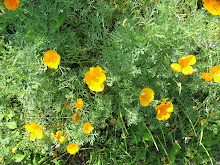

First, the good news: the sungold tomatoes have been ready for harvest, one handful at a time. Enough to contribute to a salad or veggie kabob. I also have two eggplant growing on one plant--one is about ready to pick. At about 8 feet high, my two volunteer sunflowers are the tallest in the garden. This comes at the expense of my zinnias trying to grow underneath them. They are starting to produce blooms the size of campaign buttons, not quite as large as last year.
And now the bad news: As you can see from this out-of-focus photo, something that looks like blossom end rot is appearing on another variety of tomato (don't know which--another gift from a friend). No new cases on my heirlooms, though.
I poked around the garden a bit to see how other tomatoes were doing. Still seeing more green than red; it's still July, after all. Out of respect for my fellow gardeners, I craned my neck to look under some of the fruit rather than lifting them. Inspecting all of the hundreds of tomatoes in progress in this manner would have been like trying to grow oranges in Greenland. In any case, after a good, say, 10 minutes of strolling down the curved pathways and scanning a variety of Big Boys, heirloom varieties and everything in between, I realize that I might be alone in my predicament. But it's too early to tell.






